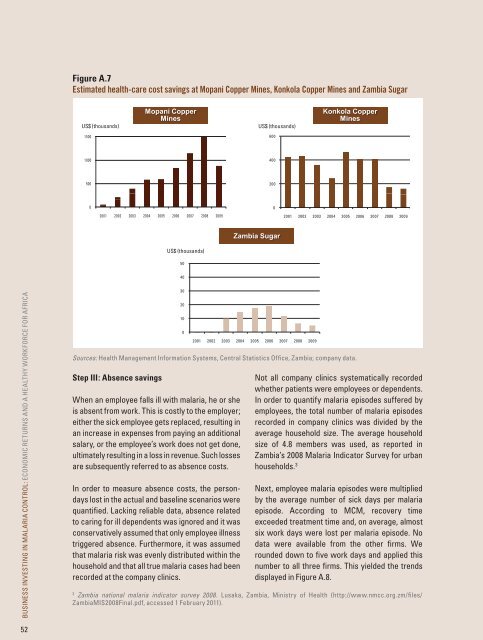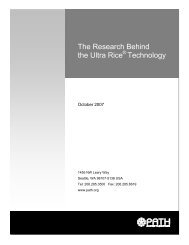Business Investing in Malaria Control: Economic Returns and ... - Path
Business Investing in Malaria Control: Economic Returns and ... - Path
Business Investing in Malaria Control: Economic Returns and ... - Path
You also want an ePaper? Increase the reach of your titles
YUMPU automatically turns print PDFs into web optimized ePapers that Google loves.
Figure A.7<br />
Estimated health-care cost sav<strong>in</strong>gs at Mopani Copper M<strong>in</strong>es, Konkola Copper M<strong>in</strong>es <strong>and</strong> Zambia Sugar<br />
US$ (thous<strong>and</strong>s)<br />
<br />
<br />
US$ (thous<strong>and</strong>s)<br />
<br />
<br />
1500<br />
600<br />
1000<br />
400<br />
500<br />
200<br />
0<br />
0<br />
2001 2002 2003 2004 2005 2006 2007 2008 2009<br />
2001 2002 2003 2004 2005 2006 2007 2008 2009<br />
<br />
US$ (thous<strong>and</strong>s)<br />
50<br />
40<br />
BUSINESS INVESTING IN MALARIA CONTROL: ECONOMIC RETURNS AND A HEALTHY WORKFORCE FOR AFRICA<br />
30<br />
20<br />
10<br />
0<br />
2001 2002 2003 2004 2005 2006 2007 2008 2009<br />
Sources: Health Management Information Systems, Central Statistics Office, Zambia; company data.<br />
Step III: Absence sav<strong>in</strong>gs<br />
When an employee falls ill with malaria, he or she<br />
is absent from work. This is costly to the employer;<br />
either the sick employee gets replaced, result<strong>in</strong>g <strong>in</strong><br />
an <strong>in</strong>crease <strong>in</strong> expenses from pay<strong>in</strong>g an additional<br />
salary, or the employee’s work does not get done,<br />
ultimately result<strong>in</strong>g <strong>in</strong> a loss <strong>in</strong> revenue. Such losses<br />
are subsequently referred to as absence costs.<br />
In order to measure absence costs, the persondays<br />
lost <strong>in</strong> the actual <strong>and</strong> basel<strong>in</strong>e scenarios were<br />
quantified. Lack<strong>in</strong>g reliable data, absence related<br />
to car<strong>in</strong>g for ill dependents was ignored <strong>and</strong> it was<br />
conservatively assumed that only employee illness<br />
triggered absence. Furthermore, it was assumed<br />
that malaria risk was evenly distributed with<strong>in</strong> the<br />
household <strong>and</strong> that all true malaria cases had been<br />
recorded at the company cl<strong>in</strong>ics.<br />
Not all company cl<strong>in</strong>ics systematically recorded<br />
whether patients were employees or dependents.<br />
In order to quantify malaria episodes suffered by<br />
employees, the total number of malaria episodes<br />
recorded <strong>in</strong> company cl<strong>in</strong>ics was divided by the<br />
average household size. The average household<br />
size of 4.8 members was used, as reported <strong>in</strong><br />
Zambia’s 2008 <strong>Malaria</strong> Indicator Survey for urban<br />
households. 3<br />
Next, employee malaria episodes were multiplied<br />
by the average number of sick days per malaria<br />
episode. Accord<strong>in</strong>g to MCM, recovery time<br />
exceeded treatment time <strong>and</strong>, on average, almost<br />
six work days were lost per malaria episode. No<br />
data were available from the other firms. We<br />
rounded down to five work days <strong>and</strong> applied this<br />
number to all three firms. This yielded the trends<br />
displayed <strong>in</strong> Figure A.8.<br />
3<br />
Zambia national malaria <strong>in</strong>dicator survey 2008. Lusaka, Zambia, M<strong>in</strong>istry of Health (http://www.nmcc.org.zm/files/<br />
ZambiaMIS2008F<strong>in</strong>al.pdf, accessed 1 February 2011).<br />
52
















